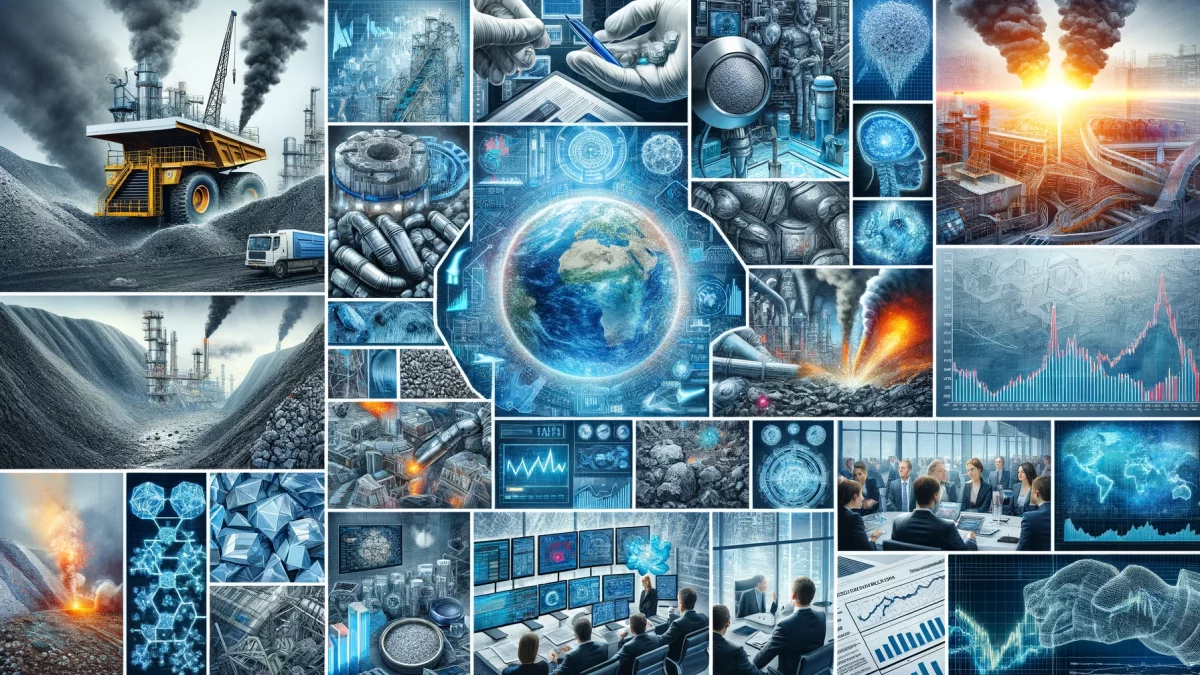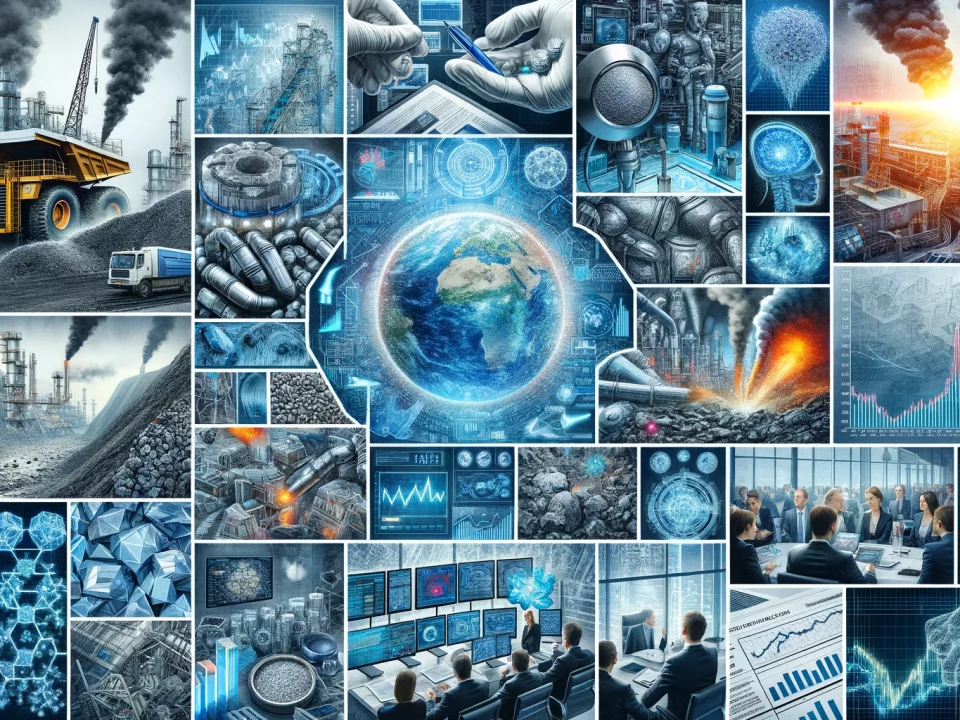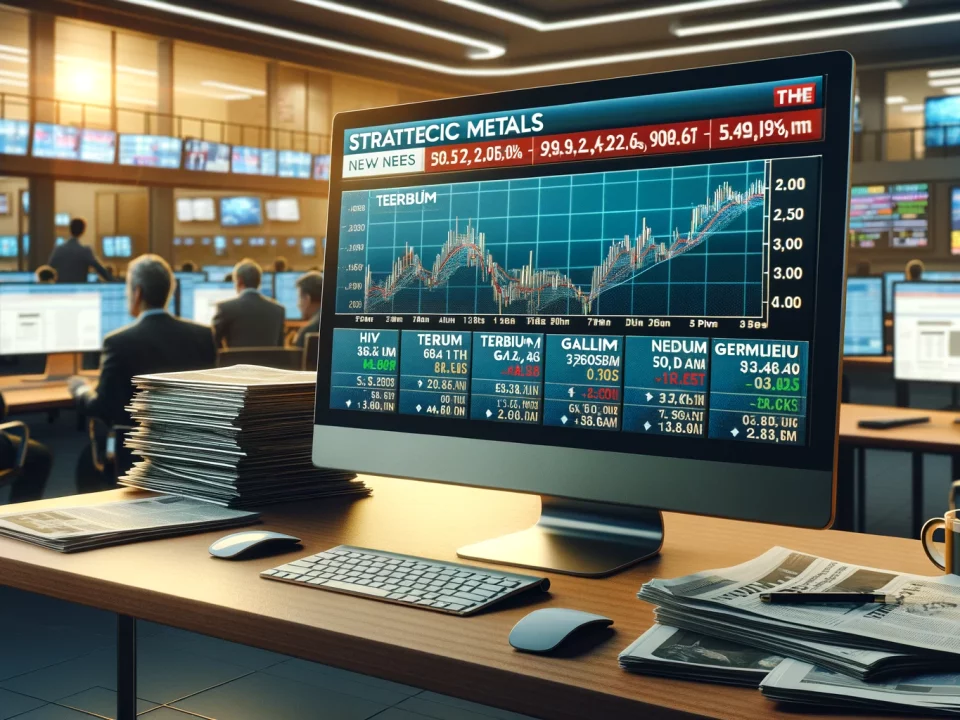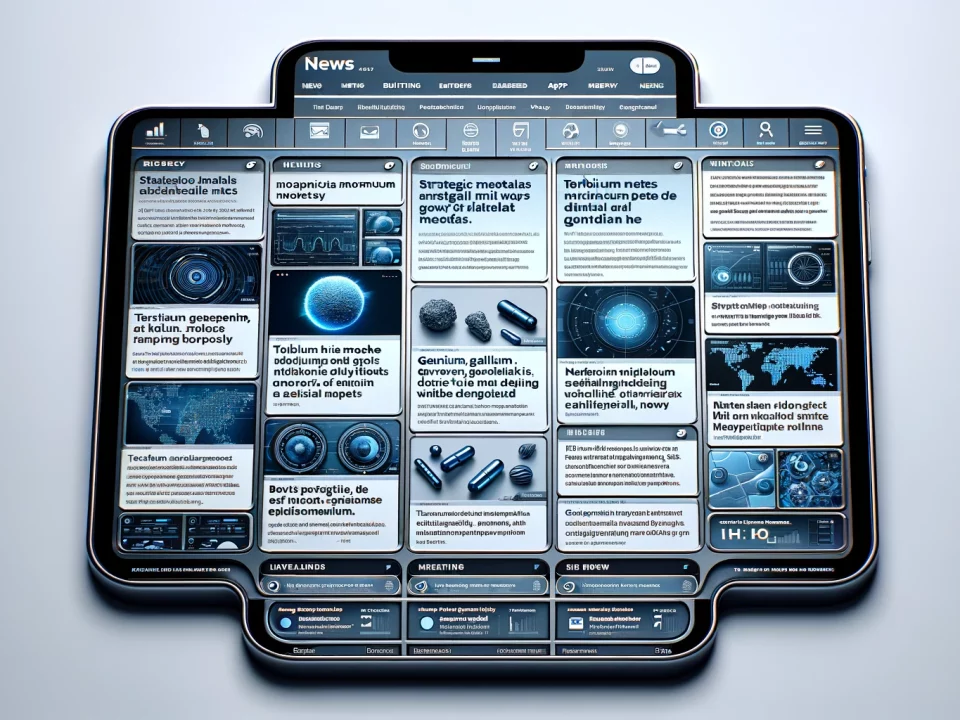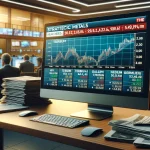
Weekly News Review March 24 – 30 2025
March 30, 2025
Weekly News Review April 7 – 13 2025
April 13, 2025Welcome to our weekly news review.
U.S. policy shifts continue to shape the raw materials landscape. While the latest round of trade tariffs exempts several critical minerals, deep-sea mining may accelerate faster than expected. Meanwhile, Russia has opened the door to potential rare earth collaboration with the U.S. China responds to U.S. tariffs with export restrictions on rare earths.
RARE EARTHS: RUSSIA FLOATS COOPERATION WITH THE UNITED STATES –
Talks have reportedly begun, according to the head of the Russian Direct Investment Fund.
Nearly two weeks ago, Kirill Dmitriev, CEO of the Russian Direct Investment Fund (RDIF), floated the idea of cooperation between Russia and the United States in developing Russia’s rare earth deposits. This initiative is gaining traction. According to Interfax and other sources, discussions have already started. The Russian news agency cites an interview with Dmitriev in Izvestia, in which he stated that several U.S. companies have expressed interest in related projects.
The RDIF is currently assessing rare earth extraction in the Murmansk region. Additionally, as Dmitriev recently announced, a dedicated fund is being planned to support infrastructure development in Arctic regions. Foreign investors may also have the opportunity to participate. These areas hold vast yet largely untapped mineral resources.
Despite its significant rare earth reserves, Russia remains a minor player in the industry. In 2023, its production stood at 2,600 tons compared to China’s dominant 240,000 tons.
CANADA PUSHES APPROVAL FOR DEEP SEA MINING:
U.S. Government to help; Bypassing the International Seabed Authority could spark tensions.
Deep-sea mining—the extraction of minerals from the ocean floor—is a potential solution to the growing demand for raw materials. However, its environmental impact remains insufficiently studied, prompting countries like France and Germany to advocate for a moratorium.
In contrast, the Canadian company The Metals Company (TMC) has been pushing for years to obtain approval for harvesting mineral resources in the Clarion-Clipperton Zone, a vast area in the central Pacific.
While nations have the sovereign right to exploit seabed resources within their territorial waters, mining in international waters falls under the International Seabed Authority’s (ISA) jurisdiction. The ISA has not granted any permits for commercial deep-sea mining, effectively halting extraction efforts in these contested areas. However, TMC is unwilling to accept this standstill, pointing to its significant financial investments in the venture.
Now, the U.S. government is being called upon to intervene by granting an exploration and mining license under the Deep Seabed Hard Mineral Resources Act—a move based on national legislation. Bloomberg cites legal expert Duncan Currie as saying that if approved, this circumvention of the ISA would constitute a violation of the United Nations Convention on the Law of the Sea (UNCLOS).
The issue has reached the highest levels in Washington following a meeting between TMC representatives and government officials. Citing insider sources, Reuters reports that a presidential executive order is even under consideration for fast-track mining operations in international waters. Given the intensifying global race for resources, such a move could heighten geopolitical tensions.
EUROPE: RESEARCHERS MAKE PROGRESS WITH THE TINIEST OF ROBOTS TO NAVIGATE THE HUMAN BODY –
Scientists at the Max Planck Institute are making progress toward tiny robots that can navigate the human body.
Tiny medical robots that can precisely navigate the human body are becoming a reality, thanks to researchers at the Max Planck Institute for Intelligent Systems. The foundation of this breakthrough lies in microalgae—single-celled organisms that are only a millionth of a meter in size and naturally swim through their environment. Propelled by two whip-like flagella at the front, their rapid movements resemble breaststroke swimming.
The research team coated the microorganisms with a magnetic material to precisely steer them. External magnetic fields, generated by two permanent magnets, guide the algae’s swimming direction. The lead researchers, Birgül Akolpoglu and Saadet Fatma Baltaci had previously tested this principle with bacteria-based microswimmers using rare earth permanent magnets.
Faster Than Olympic Swimmers:
The modified microalgae were then tested in an environment similar to human tissue: narrow spaces in a viscous liquid with a density comparable to mucus. The results were striking: The additional load barely affected the swimming robots. According to the researchers, their average speed was 115 micrometers per second—around 12 body lengths per second. For comparison, an Olympic swimmer like Michael Phelps, who can also use his legs for propulsion, reaches about 1.4 body lengths per second. The magnetic control even enhanced the algae’s swimming performance, as without it, the algae would often get stuck in the confined space and return to the starting point. Akolpoglu compares the system to a tiny GPS.
The researchers now plan to optimize their development further. These findings pave the way for applications such as drug-targeted, biocompatible delivery. They could also be used in other scenarios where microrobots must be guided through hard-to-reach environments.
US TARIFFS: STRATEGIC METALS AND SEMICONDUCTORS SPARED FOR NOW –
The new tariff policy imposes broad import duties on all countries, with some facing higher rates.
On Wednesday, U.S. President Donald Trump announced a fresh round of trade tariffs, targeting imports from multiple countries. According to the White House, the new levies are intended to bring manufacturing back to the United States and address trade imbalances.
The policy introduces a 10% baseline import tariff on all countries, with higher rates for nations with restrictive trade barriers. While framed as a broad tariff on imports, the measure exempts several key goods. Steel, aluminum, and auto and auto parts remain untouched as they are already subject to Section 232 tariffs. Meanwhile, for now, copper, pharmaceuticals, semiconductors, and lumber are explicitly excluded. However, a White House official told Reuters that these items could be subject to future tariffs.
Energy and “Certain Minerals” Excluded:
Energy and certain minerals not available in the U.S. are also exempt. The list of exempted minerals and energy-related products can be found here. It includes items such as rare earths, gallium, and germanium. Most of these minerals are sourced from China, which faces one of the highest tariff rates—34% on top of an existing 20%, bringing the total to at least 54%. In response, Beijing has vowed to retaliate, though it has not yet provided specific details. The European Union, meanwhile, stated that it would be “ready to negotiate” regarding trade barriers with the U.S. but would respond to any unfair levies.
AUSTRALIA RESPONDS TO US TARIFFS –
Prime Minister Anthony Albanese unveiled a five-point plan to address the latest U.S. trade policy announcement.
Australian Prime Minister Anthony Albanese outlined a five-point plan on Friday in response to U.S. President Donald Trump’s latest round of trade tariffs. With a federal election looming in May, Albanese offered reporters a glimpse into how his administration intends to address the evolving U.S. trade stance. While financial support for industries most affected by the tariffs is among the core points, Albanese emphasized Australia’s strategic advantage: its rich reserves of critical minerals.
The prime minister plans to establish a “Critical Minerals Strategic Reserve,” which would prevent some commodities from being exported and make the country more resilient against global trade measures. It would also give Australia more leverage and influence in the international critical minerals supply chains.
Sweeping U.S. Tariffs Exclude Critical Minerals, Highlighting Their Importance:
U.S. President Donald Trump announced sweeping import tariffs on nearly all countries worldwide on Wednesday. Although presented as a blanket levy on most goods, key exceptions were made—notably for critical minerals—underscoring the growing recognition of their strategic importance to global economies.
Australia is already a major player in the global critical minerals landscape, holding the world’s second-largest reserves of lithium and manganese, according to data from the U.S. Geological Survey. The country is also among the top producers of rare earth elements, nickel, silver, tin, and a wide range of other critical minerals. With the Future Made in Australia Act, the country seeks to strengthen its position further.
Industry Body Applauds Plan:
The Australian Association of Mining and Exploration Companies (AMEC), representing over 500 industry members, welcomed the proposal, noting it could elevate Australia’s role in strategic global discussions. However, AMEC stressed that a more detailed plan is needed before the proposal can be fully assessed.
EUROPE SEEKS TO EXPAND INFLUENCE IN CENTRAL ASIA:
Critical raw materials, energy, transportation routes, and digitalization are the key sectors the European Union plans to support in Central Asia with €12 billion in funding. The announcement was made at the first EU-Central Asia summit in Samarkand, Uzbekistan, where representatives from both sides pledged to strengthen their strategic partnership. The funds will come from the EU’s geopolitical investment program, Global Gateway.
Amid growing geopolitical tensions, the EU is focused on diversifying its raw material sources and reducing dependency on specific suppliers. The landlocked countries of Kazakhstan, Kyrgyzstan, Tajikistan, Turkmenistan, and Uzbekistan are viewed as potential alternatives to China, with vast, often untapped reserves of critical resources like rare earth elements. Just this week, Kazakhstan reported the discovery of its largest rare earth deposit, estimated at 20 million tons. The EU has ramped up cooperation with countries like Kazakhstan in the past already, pledging further investment.
Raw Material Partnerships: Europe Aims to Distance Itself from China:
China and Russia still wield significant economic and political influence in the region. Chinese companies, for example, hold the majority of mining licenses and operations in Kyrgyzstan and Tajikistan, while, according to Euractiv, most mineral exports from Kazakhstan and Uzbekistan currently go to China.
However, as EU Commission President Ursula von der Leyen emphasized in her speech at the summit, Europe’s approach is distinct. Europe’s goal is to extract raw materials for its own use and create added value across the entire local supply chain—from mining and refining to research and training. Von der Leyen also announced a joint declaration on critical raw materials designed to attract significant private investments to the region, and an investor forum was planned for later this year in Uzbekistan.
How successful these efforts will be remains to be seen. Alongside traditional ties to Russia and China, countries like the United States are increasingly interested in Central Asia’s raw materials. Some analysts criticize the EU’s relatively slow pace, noting that the Union has been involved in very few regional projects, despite decades of cooperation with these governments, as Roman Vakulchuk of the Norwegian Institute of International Affairs told Euractiv.
CHINA RESPONDS TO US TARIFFS WITH EXPORT CONTROLS ON RARE EARTHS –
Earlier this week, the U.S. government imposed punitive tariffs on imports from various countries. The tariff rates vary depending on the size of each country’s trade surplus with the United States. As a result, China is facing a steep 34% tariff.
Beijing wasted no time responding. On Friday, China announced a retaliatory tariff—also 34%—on U.S. goods, effective April 10, according to reports from outlets, including the South China Morning Post. In addition to the counter-tariff, China is introducing new export restrictions on certain rare earth elements.
Export licenses will now be required for materials such as dysprosium, terbium, yttrium, gadolinium, samarium, lutetium, scandium, and their various compounds. These measures take effect immediately.
As the world’s leading producer of these critical raw materials, China is again adopting a familiar strategy—previously seen with export controls on gallium and germanium. In those cases, exports were temporarily halted following the policy’s implementation due to processing delays in the licensing system. Whether rare earth exports will face similar disruptions remains to be seen.
Figure of the Week: – 230 BILLION – Since 2015, 230 BILLION of U.S. dollars have been invested in startups driving innovation in the energy sector.
If you want to learn more about the benefits of owning strategic metals as physical assets, please contact us to schedule a free, no-obligation introduction call.



